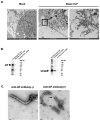Identification of Novel Adjuvants for Ebola Virus-Like Particle Vaccine
- PMID: 32397625
- PMCID: PMC7349346
- DOI: 10.3390/vaccines8020215
Identification of Novel Adjuvants for Ebola Virus-Like Particle Vaccine
Abstract
Ebola virus disease is a severe disease, often fatal, with a mortality rate of up to 90%. Presently, effective treatment and safe prevention options for Ebola virus disease are not available. Therefore, there is an urgent need to develop control measures to prevent or limit future Ebola virus outbreaks. Ebola virus protein-based virus-like particle (VLP) and inactivated whole virion vaccines have demonstrated efficacy in animal models, and the addition of appropriate adjuvants may provide additional benefits to these vaccines, including enhanced immune responses. In this study, we screened 24 compounds from injectable excipients approved for human use in Japan and identified six compounds that significantly enhanced the humoral response to Ebola VLP vaccine in a murine model. Our novel adjuvant candidates for Ebola VLP vaccine have already been demonstrated to be safe when administered intramuscularly or subcutaneously, and therefore, they are closer to clinical trials than adjuvants whose safety profiles are unknown.
Keywords: Ebola vaccine; adjuvants; virus-like particle.
Conflict of interest statement
Y.K. has received speaker’s honoraria from Toyama Chemical and Astellas; grant support from Chugai Pharmaceuticals, Daiichi Sankyo Pharmaceutical, Toyama Chemical, Tauns Laboratories, Otsuka Pharmaceutical, and Kyoritsu Seiyaku; and is a founder of FluGen. All of the other authors declare that they have no conflicts of interest.
Figures


Similar articles
-
Injectable Excipients as Novel Influenza Vaccine Adjuvants.Front Microbiol. 2019 Jan 24;10:19. doi: 10.3389/fmicb.2019.00019. eCollection 2019. Front Microbiol. 2019. PMID: 30733711 Free PMC article.
-
Recombinant Modified Vaccinia Virus Ankara Generating Ebola Virus-Like Particles.J Virol. 2017 May 12;91(11):e00343-17. doi: 10.1128/JVI.00343-17. Print 2017 Jun 1. J Virol. 2017. PMID: 28331098 Free PMC article.
-
Adjuvant-enhanced CD4 T Cell Responses are Critical to Durable Vaccine Immunity.EBioMedicine. 2015 Nov 27;3:67-78. doi: 10.1016/j.ebiom.2015.11.041. eCollection 2016 Jan. EBioMedicine. 2015. PMID: 26870818 Free PMC article.
-
Recent advances in the development of vaccines for Ebola virus disease.Virus Res. 2016 Jan 4;211:174-85. doi: 10.1016/j.virusres.2015.10.021. Epub 2015 Oct 24. Virus Res. 2016. PMID: 26596227 Review.
-
Virus-like particle vaccines: immunology and formulation for clinical translation.Expert Rev Vaccines. 2018 Sep;17(9):833-849. doi: 10.1080/14760584.2018.1516552. Epub 2018 Sep 19. Expert Rev Vaccines. 2018. PMID: 30173619 Free PMC article. Review.
References
-
- WHO Ebola Virus Disease. [(accessed on 22 January 2020)]; Available online: https://www.who.int/news-room/fact-sheets/detail/ebola-virus-disease.
-
- Hong S., Park S., Yu J.-W. Pyrin Domain (PYD)-containing Inflammasome in Innate Immunity. J. Bacteriol. Virol. 2011;41:133. doi: 10.4167/jbv.2011.41.3.133. - DOI
-
- Goldstein T., Anthony S.J., Gbakima A., Bird B.H., Bangura J., Tremeau-Bravard A., Belaganahalli M., Wells H., Dhanota J., Liang E., et al. The discovery of Bombali virus adds further support for bats as hosts of ebolaviruses. Nat. Microbiol. 2018;3:1084–1089. doi: 10.1038/s41564-018-0227-2. - DOI - PMC - PubMed
Grants and funding
- JP18am001007/Japan Agency for Medical Research and Development
- JP19fk0108056/Japan Agency for Medical Research and Development
- JP19fk0108104/Japan Agency for Medical Research and Development
- 16H06429, 16K21723, and 16H06434/Grants-in-Aid for Scientific Research on Innovative Areas from the Ministry of Education, Culture, Science, Sports, and Technology of Japan
- JP19fm0108006/Japan Agency for Medical Research and Development
LinkOut - more resources
Full Text Sources

